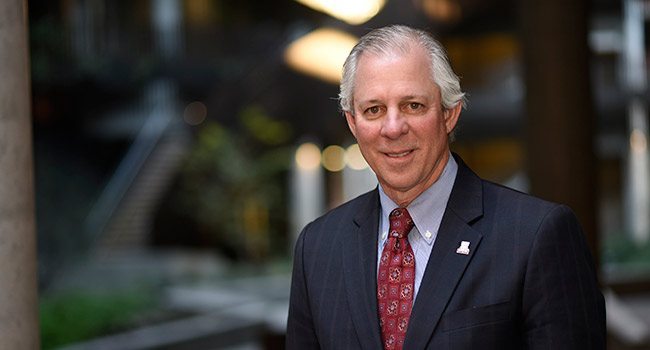On Tuesday, it was announced that Dr. Robert C. Robbins is the lone finalist to succeed the University of Arizona’s current president, Ann Weaver Hart. Robbins visited the Tucson campus on Wednesday for a day of introductory meetings, which ended with an hour-long public forum.
The Arizona Board of Regents has scheduled a special meeting for Monday to make Robbins’ selection formal and begin contract negotiations. By the board’s timetable, a contract would be finalized by April 6.
In his opening remarks and ensuing Q&A with the UA community and local media, the 59-year-old Robbins touched on the need to elevate the University’s profile, the convergence of technologies as part of a “fourth Industrial Revolution,” the UA’s partnership with Banner Health and other subjects. He said he would relish the opportunity to be the out-front ambassador for the UA.
“This is a great American university,” Robbins said, “something we should all be proud of. One of my objectives is to better tell the great story we have here at the U of A. We don’t get the coverage and attention we deserve.
“I hope to be the uniter and convener to help us speak with one voice and take this University to even higher levels.”
Describing himself as “high energy,” Robbins said the hallmarks of his administration would be transparency, accountability and accessibility. He encouraged faculty and students in the audience to “hold me accountable” for achieving goals and objectives, and he said he will be plenty visible.
“I plan to be involved in community organizations and certainly on campus,” he said. “You’ll find me out on campus a lot, going to events. I’ll be active and engaged. … I’ll go for as long as (the regents) will have me. I’d hope that would be at least 10 years and maybe 15. That’s probably getting close to the natural expectancy of this position.”
The UA has had four presidents over the past 20 years, and continuity of leadership was a stated priority of the 27-member search committee, which began its work in September. More than 100 prospects were identified before the field was narrowed to two candidates: Robbins and Sethuraman “Panch” Panchanathan, an Arizona State University vice president.
Robbins noted that his road to success had humble beginnings at a small liberal-arts school in southern Mississippi, Millsaps College, where he saw live theater for the first time and realized the importance of the humanities to a well-rounded education. He said that exposure to the arts “changed my life and how I viewed the world.”
His path took him to the University of Mississippi, Stanford University, Columbia University and the National Institutes of Health as he built a career as a cardiac surgeon, focusing his clinical efforts on acquired cardiac diseases with a special expertise in the surgical treatment of congestive heart failure and cardiothoracic transplantation. In his four years as president and CEO at TMC in Houston, he has built partnerships in biotech and the life sciences with Johnson and Johnson, AT&T and various imaging companies.
He said the UA’s strengths in fields such as agriculture, space science and cybersecurity are ripe to be exploited in a similar fashion.




